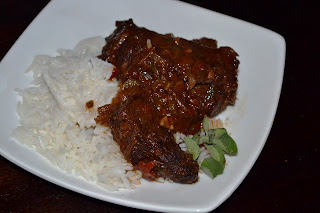Feeling Cheeky? Try Some Braised Beef Cheeks!
It's damn near impossible (at least for me) to take a picture of braised meat that looks half way decent, but you'll just have to trust that it tastes amazing.
Beef cheeks, you ask? Are those what I think they are? Yes, they are on-the-face-cheeks, not rear-end-cheeks. They're a tough, fat and sinew-marbled piece of meat, and are surprisingly big, as evidenced below:
Big hunks of meat, huh? (And that's just two.) Anyway, somewhere along the way I read an article about beef cheeks and decided to give them a go. After talking to the fine folks at Bluescreek Farms, I pre-ordered a "bunch" of cheeks and picked them up a week later...A bunch turned out to be about five and a half pounds for $18. A pretty good bargain, I'd say.
I took home my bag o'cheeks and surfed the internet for ideas. (Not happening: The French Laundry's "Tongue in Cheek"--not because I'm anti-tongue, but I was really not interested in a three day project.)
Essentially, you can treat these like you would a pot roast or a Boston Butt (if we're talking pork): season, sear, then braise low and slow for four or five hours. I went with a classic pot-roast flavor profile: sauteed onions, garlic, and celery in bacon fat (would have used carrots had I had them on hand), with a handful of whatever fresh herbs I had in the pots out front, some wine, tomatoes, and beef broth. (I used this Epicurious recipe as a jumping-off point.)
Essentially, you can treat these like you would a pot roast or a Boston Butt (if we're talking pork): season, sear, then braise low and slow for four or five hours. I went with a classic pot-roast flavor profile: sauteed onions, garlic, and celery in bacon fat (would have used carrots had I had them on hand), with a handful of whatever fresh herbs I had in the pots out front, some wine, tomatoes, and beef broth. (I used this Epicurious recipe as a jumping-off point.)
To prep the cheeks for cooking you have to trim the excess fat and silver skin off them (NB: make sure your knives are sharpened when you do this, it's a pain--and potentially dangerous--with dulled knives!), and cut them into manageable chunks. At this point, I decided to just cook about two and a half pounds of the cheeks and save the rest for another day.
Then, as I said, you season the meat really well with salt and pepper, sear it on all sides in a Dutch oven (or large pot with a lid) in olive oil or bacon grease (ANOTHER reason to save your bacon grease, see also these cookies), then remove the darkly browned meat, and cook the onions, celery, garlic, and carrots until soft. Add some broth and scrape up all the fond-y goodness (fond: a deposit of caramelized sugars, carbohydrates, and/or proteins forms on the bottom of the pan, along with any rendered fat, sucs, in French) since that's where a lot of your really great flavor is going to come from. Add the meat back to the pot, a little more broth, the tomatoes, whatever herbs/spices you have on hand, and put it all in the oven at about 300 degrees and ignore it for the bulk of your day.
It's done when you stick a fork in the meat and it falls apart. If you want to, you can remove the meat and simmer the cooking liquid until it reduces to more of a sauce, at which point I strongly encourage you to have a loaf of crusty bread on hand for dipping purposes. Severed over rice (as in the picture above) it's delicious, served over homemade pasta (or egg noodles or gnocchi) it's incredible. Leftovers are better the next day if you pop it in the fridge then reheat it in the oven.
So, get thee to your butcher, order up some beef cheeks and try your hand at one of nature's under-appreciated cuts. Your taste buds, your friends (and your wallet) will thank you.




Comments